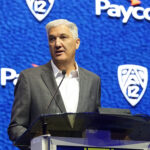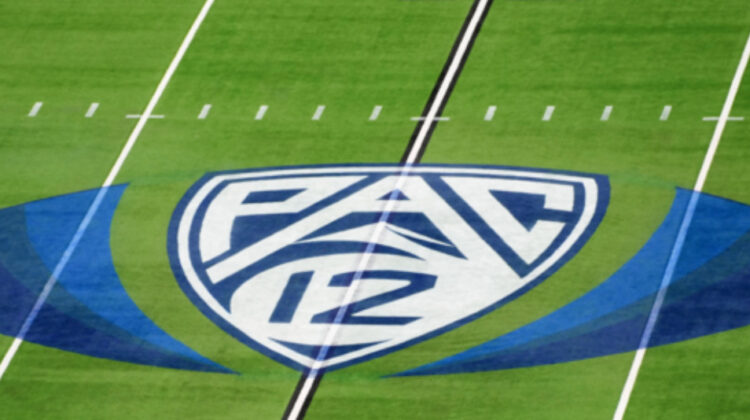LAS VEGAS, Dec. 2, 2033 — Utah head coach Morgan Scalley emerged from a jubilant locker room and headed straight for his family waiting nearby. This was a victory for the new era, after all: the 2033 Pac-14 championship, secured with a dominant performance against underdog Stanford.
Scalley would address the specifics during his postgame news conference. But here, in the moment, he paused the chat with a small group of reporters.
“What a ride this has been,” he said.
In more ways than one.
The victory established Utah as the premier program in the first season of the Pac-14. Given up for dead a decade ago, the conference reformed after the breakup of the Power Four and now features many former members, including Utah, Stanford, UCLA and the Arizona schools, plus a few new ones. (Hello, Brigham Young!)
“This is what college sports is supposed to be about,” Scalley added. “They can have their money and their collective bargaining. We’re thrilled with how everything turned out.”
He was referring, of course, to the CFB SuperLeague — the group of 24 programs that left the NCAA in the early 2030s to form their own entity. (Some have derisively called it NFL Lite, or NFL 2.0.)
Scalley’s joy was understandable. A decade ago, he served as Utah’s defensive coordinator during the program’s transition from the Pac-12 to the Big 12. He accepted the change but, like retired Utah legend Kyle Whittingham, never fully embraced the new conference structure and worried the sport was destroying itself from within.
“I don’t know that I would have predicted the events that led us to this point,” Scalley said, “but I’m thrilled it unfolded the way it did.”
The slow death and stunning rebirth of the conference began back on June 30, 2022, when USC and UCLA announced they would flee for the Big Ten, sending the Pac-12 into an existential crisis.
The following summer, after former commissioner George Kliavkoff failed to secure a satisfactory media rights agreement, eight more schools fled the conference.
Only Colorado was truly happy about the new arrangement — the Buffaloes were returning to their longtime home in the Big 12. For everyone else, changing conferences was a last resort, a move rooted in frustration and desperation.
The fall of 2023 produced one of the most riveting seasons in conference history, with No. 3 Washington and No. 5 Oregon squaring off for the championship. Off, the field, the schools engaged in a legal fight over control of the assets and revenues.
Eventually, Washington State and Oregon State, the universities left behind in the realignment game, would reach a mediated settlement with the 10 departing members and take control of what was unofficially termed the ‘Pac-2’ conference.
The Cougars and Beavers scrambled to secure a scheduling agreement with the Mountain West that spanned two bizarre seasons, then executed a full merger with the MW, albeit with a caveat: The new configuration retained the Pac-12’s name, allowing the schools to benefit from the historic conference’s intellectual property value.
Under then-commissioner Gloria Nevarez, the conference signed a media rights deal with Fox, CBS and Apple that began in the fall of 2026 and spanned the remainder of the decade.
At that point, the realignment wave of the early 2020s subsided and the Football Bowl Subdivision structure was set — at least in the short term, for the foundation was anything but stable.
As the sport flourished under the 12-team playoff format, the NCAA’s economic model was blown to smithereens. The agent of destruction: A class-action antitrust lawsuit filed by former Arizona State swimmer Grant House.
House and his attorneys claimed thousands of college athletes in all sports were entitled to years of backpay from the NCAA for the use of their name, image and likeness (NIL).
That would have been damaging enough for the NCAA, since penalties in antitrust suits are tripled. But House argued that NIL accounted for 10 percent of the value of each conference’s TV deals, which pushed the potential damages into the billions.
Days before the trial, in January 2025, the defendants — the NCAA and what was then known as the Power Five — reached a settlement with landscape-changing repercussions:
— The schools were forced to pay $3 billion to the House plaintiffs for compensation prior to NIL becoming legalized in 2021.
— Starting in the 2028 fiscal year, 8.5 percent of all media rights revenue distributed from the TV networks to the power conferences was earmarked for athletes, with football and basketball players receiving an outsized portion in a revenue-sharing agreement that changed everything.
The math was daunting. Schools in the Big Ten, for example, were forced to distribute tens of millions of dollars in NIL backpay and share $90 million annually in media rights (from the contract with Fox, CBS and NBC) with the athletes.
What followed would once have seemed unimaginable but, by the mid-2020s, was considered inevitable: Athletic departments across the country were forced to downsize, with Olympic sports taking the biggest hit.
Schools reduced scholarship counts and scaled back on infrastructure. They even outsourced operations.
It wasn’t enough to offset the House impact. Why? Because the costs associated with sending soccer and softball teams across the country for conference play, long a detriment to the athletes’ well-being, became financially untenable for the schools.
The result was a massive wave of realignment at the Olympic sports level.
Regional leagues were created, all modeled on the Mountain Pacific Sports Federation, which for years sponsored sports like water polo, fencing and gymnastics for schools based in the Mountain and Pacific Time Zones.
The restructuring of Olympic sports helped trim costs but was ultimately the equivalent of using a Band-Aid to treat a severed limb.
Because the House case wasn’t the only stress on the system.
In the mid-2020s, the National Labor Relations Board circumvented legal precedent and determined college football and basketball players met the criteria for employment status.
Thought to have oversight only over private universities, the NLRB filed a complaint against USC that cleverly named the NCAA as a joint employer, thus clearing the path for jurisdiction over athletes at all public universities under the NCAA umbrella.
After a lengthy courtroom process, athletes were given legal protection to collectively bargain for better working conditions from the NCAA. The ultimate benefits would include a groundbreaking expansion of coverage for mental and physical health.
With costs soaring as a result of the House settlement and the NLRB ruling, and with the market for coaching salaries steadily rising — in 2031, Alabama’s Nick Saban became the first $20 million coach after winning his 11th national title — athletic departments from coast to coast were under immense pressure to find new sources of revenue.
Naturally, they identified media rights contracts as an option. But by the late 2020s, the media landscape had changed dramatically:
— Cord-cutting accelerated through the decade, leaving the cable bundle at approximately 25 percent of all U.S. households. (In 2023, it was 46 percent.)
— ESPN’s direct-to-consumer platform, launched in 2026, had approximately 15 percent of all TV homes.
— Cable companies pivoted their strategy, with broadband access as the priority and video delivery a secondary priority.
Most significantly, technological advancement led to the creation of a single, integrated platform in which viewers could seamlessly move between linear and streaming video delivery. (Consumers no longer had to close an app to move from Apple to ESPN.)
But the same viewership trends that dominated the early 2020s held through the later years. Live sports and news dominated consumption, but the media companies became more selective in their pursuit of college football inventory.
All those forces were at work as the Big Ten stepped to the table in early 2029 to begin negotiating a new media rights contract.
By this point, the Big Ten was as stable as the ACC had been in 2023 (i.e., not very). Ohio State, Michigan, Penn State and USC, under enormous financial pressures, locked arms and insisted the conference eliminate its equal-share revenue model.
The resulting agreement, orchestrated by commissioner Jen Cohen, funneled a large portion of the media rights revenue to a handful of schools, making it difficult for others to compete.
(On the social media platform Y, speculation was rampant that Alabama, Georgia and Texas would take the same approach when the SEC media negotiations began a few years later.)
Below the surface, the foundation for traditional media rights deals was liquefying.
The Big Ten’s broadcast partners had grown weary of paying huge sums for second-tier games like Minnesota vs. Illinois and Indiana vs. Rutgers. They no longer had use for agreements with entire conferences; they wanted deals with specific schools — with the schools that drove the ratings.
After months of negotiations, a deal was reached that signaled the beginning of the end of the conference structure: Fox, which controlled the Big Ten’s inventory, worked with the conference’s bluebloods on a long-term contract that, crucially, featured an out clause following Year 3 — in the summer of 2033.
The following year, Fox and ESPN worked similar language into the Big 12’s media deal. (The terms did not sit well with a conference that had enjoyed immense security and alignment throughout the 2020s, but the schools had no choice: The networks were dug in.)
Why were the out clauses hooked to the summer of 2033? Because the window lined up with the final year of the SEC’s media contract, which ESPN could void, at a reasonable but negotiated cost, if it so desired.
So as the 2030s began, the contractual framework was in place for the top-tier programs to opt out of their media deals. Legally and politically, the escape clause made sense. It was far cleaner for the bluebloods to form a new entity than it would have been to kick low-end programs out of the existing leagues.
Bob Thompson, the former Fox Sports president and keen observer of the college football landscape, coined the phrase “up and out” back in the fall of 2023 — and it stuck.
There was one last obstacle to “up and out,” however: the mechanism for creating the CFB SuperLeague.
After all, Title IX concerns and antitrust laws formed a daunting collective opposition to any entity created by breakaway schools and their media overlords.
But consultants had quietly been working the problem for years. Their solution: Create a new college football entity, outside the NCAA’s purview, owned and operated by a third party with the cash to fund operations in the early years.
At one point, in fact, consultants reached out to executives at Saudi Arabia’s sovereign wealth fund — the entity behind LIV Golf — about providing the financial backing. University presidents eventually quashed the idea, petrified of the backlash on campuses and across state and local governments.
But the broader concept endured: Private equity could offer salvation and shield the new entity from certain legal challenges. It needed the right frontman, however — someone who could work behind the scenes with the key presidents and who understood the power of college football.
The choice: Mark Keenum, the former Mississippi State president.
Keenum had been the force behind College Football Playoff expansion in 2022, after the conference commissioners couldn’t agree on a format. The former small-college football player stepped down from his post in Starkville in 2029, after two decades on the job, but didn’t hesitate to accept the new role. (His presence ensured that Mississippi State and Ole Miss would be included in the CFB SuperLeague.)
There were numerous logistical challenges. But thanks to the private equity support and the opt-out clauses in the media contracts, most hurdles were solved with relative ease:
— The 24-team CFB SuperLeague played a 14-game schedule that began in late August on what was formerly known as Week Zero. (This was an easy sell, as countless studies showed the traditional four-week training camps were the primary source of head trauma in college football.)
— The league was divided into four divisions of six teams, with no consideration given to geography. Schedules were based on the previous season’s standings, although each team had two protected games.
— The 12-team playoff was modeled after the NFL and featured four rounds of play beginning the second week of December.
— All the bluebloods were involved, along with a handful of second-level programs from the SEC and Big Ten.
— Three schools from what was once known as the Pac-12 made the cut: USC, of course, along with Oregon and Washington.
(UCLA, which was part of the original West Coast exodus to the Big Ten, did not have the competitive success, financial wherewithal, TV ratings or brand clout to gain inclusion.)
The final piece — the political and legal pushback from schools left behind in the ACC, Big Ten, SEC and Big 12 — was solved in fairly smooth fashion, courtesy of an unlikely source: the high-end academic universities.
Their resistance to the concept of a super league began years earlier, when the House case and NLRB ruling created a revenue-sharing model for college athletics and diminished the value of, and funding for Olympic sports.
Stanford and Cal set the chain of events in motion in the late 2020s after realizing life in the ACC was untenable for their athletes in every sport save football. Once the Bay Area schools reset their mission, Duke, Vanderbilt and Northwestern were quick to follow.
(The creation of regional conferences for Olympic sports gave the academic-oriented schools enough cover to extricate themselves from the football machinery that created the CFB SuperLeague.)
Eventually, the schools excluded from the CFB SuperLeague embraced a mission for higher education tweaked to fit the 2030s: a sustainable model that used college athletics as the vehicle to provide academic opportunities and create community leaders and an empowered workforce.
As the bluebloods executed the out clauses in the media deals — and as private equity took charge of the CFB SuperLeague — the remaining 40-something football schools in what had once been the Power Five reformed across regional, sensible lines.
As everyone knows by now, Arizona, Arizona State, Utah and Brigham Young left the Big 12 to join UCLA, Stanford, Cal, Washington State and Oregon State — plus the top-tier football schools in the Mountain West — in a reconstituted Pac-14. (The Big 12, ACC and Big Ten are comparable in size and regionality.
The conference had no trouble finding a TV deal. Despite all the dollars thrown at the CFB SuperLeague, the demand for quality college football, with abundant regional rivalries, created a healthy media market.
The budgets were smaller than those of the SuperLeague schools and the number of sponsored sports was smaller, but the on-field competition flourished. (Everyone loves their alma mater; and everyone loves college football.)
Leaders of the regional conferences smartly dipped into the past for a postseason model. Fresh off their victory over Stanford in the 2033 Pac-14 championship game, the Utes will play Wisconsin in the Rose Bowl.
“We’ll take two weeks off for final exams and some rest,” Scalley explained, “then get right back to it. You can have your SuperLeague. These kids are still college students, after all.”
*** Editor’s note: Scalley was not interviewed for this article and has not been named Utah’s ‘coach-in-waiting.’ His comments are fictional.
*** Send suggestions, comments and tips (confidentiality guaranteed) to pac12hotline@bayareanewsgroup.
*** Follow me on Twitter: @WilnerHotline
*** Pac-12 Hotline is not endorsed or sponsored by the Pac-12 Conference, and the views expressed herein do not necessarily reflect the views of the Conference.
Related posts:
 Wilner Hotline: Sunday Reactions to Pac-12 Saturday, Devilish Downturn
Wilner Hotline: Sunday Reactions to Pac-12 Saturday, Devilish Downturn 
(AP Photo/Damian Dovarganes, File)
Pac-12 survival: Oregon, Washington to deliver the death blow, leave for the Big Ten; more defections expected
(AP Photo/Lucas Peltier)
The Pac-12’s stellar football season, the media rights collapse and the enduring disconnect that defines the conference Mailbag: The problem with promotion and relegation, options for WSU and OSU, Kliavkoff’s duties, the Pac-12 Networks’ future and more
Mailbag: The problem with promotion and relegation, options for WSU and OSU, Kliavkoff’s duties, the Pac-12 Networks’ future and more
